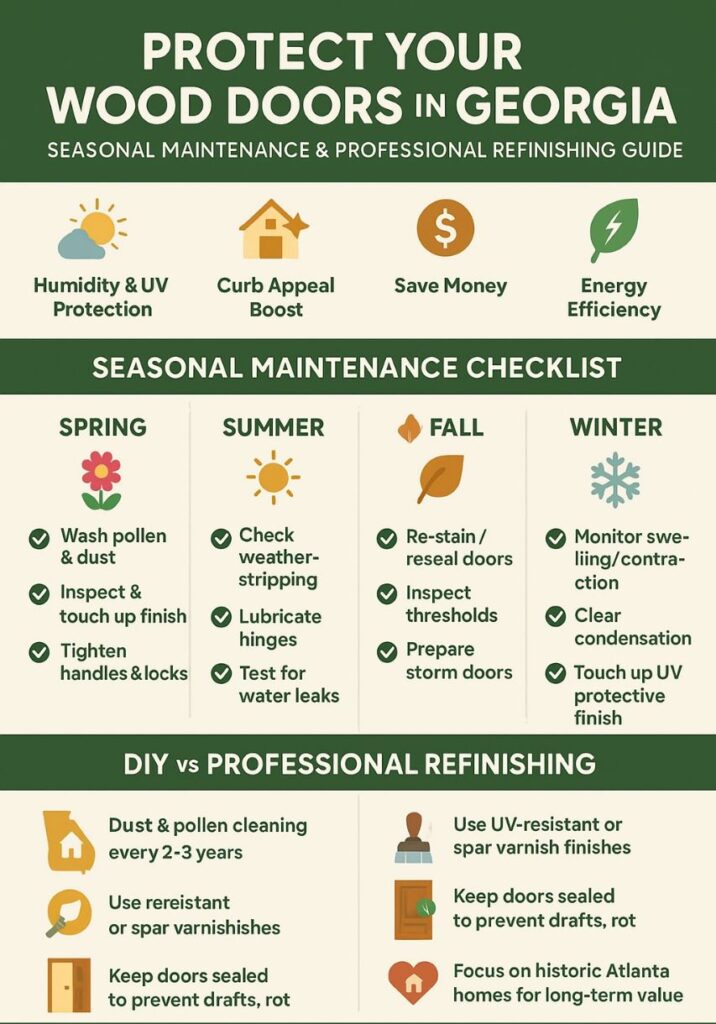In Georgia’s challenging climate—where humidity, storms, and strong sunlight constantly test wooden doors—the choice between paint and stain isn’t just about looks. It determines durability, curb appeal, and long-term savings.
For homeowners seeking lasting protection, professional door refinishing with DoorStain offers a proven solution. Our team delivers on-site service across Georgia, using premium finishes designed for humid Southern weather—backed by 15+ years of expertise and 24/7 availability.
Appeal & Durability
Atlanta’s humid summers, sudden thunderstorms, and blazing sunlight constantly challenge wooden entryways. Choosing between paint and stain is not only a design decision—it’s about science, craftsmanship, and protecting your home. The finish you choose directly impacts longevity, beauty, and future costs.
Why Exterior Doors Matter in Atlanta Homes
Wooden front doors are a hallmark of Southern charm and one of the biggest drivers of curb appeal. Whether in Buckhead, Midtown, or Decatur, doors shape the personality of entire homes. A wooden entry door is more than an entrance—it’s the face and identity of your home.
Georgia’s Climate: The Stress Test for Exterior Doors
Georgia’s subtropical climate creates unique challenges:
- High Humidity: causes swelling, mildew, and trapped moisture.
- Strong UV Rays: fade even rich colors, especially on south-facing doors.
- Storms: heavy rain penetrates panels and edges.
- Seasonal Cycles: expansion in summer, contraction in winter → cracking and warping.
These conditions mean your door finish must act as a protective shield, not just decoration.
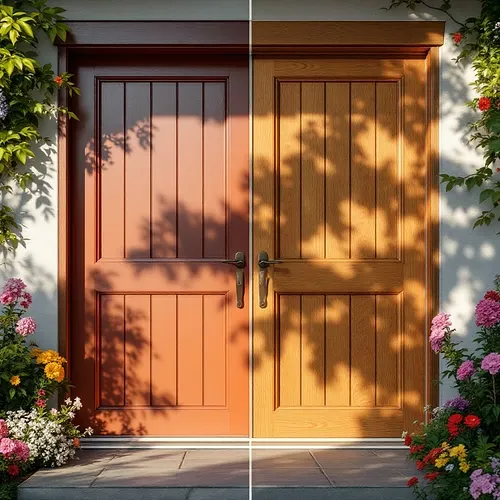
Paint vs Stain — Which Performs Better?
When it comes to protecting and enhancing wood, choosing between paint and stain is like deciding between two very different styles of armor.
-
Paint acts like a raincoat, blocking UV but peeling once moisture seeps in.
-
Stain works like sunscreen, penetrating the wood and allowing it to breathe.
Stain adapts better to Atlanta’s humidity, while paint performs best in drier climates.
The University of Georgia Extension provides guidance showing that breathable finishes like oil-based stains are more durable than film-forming paints in the state’s humid subtropical climate.
Pros & Cons of Paint for Georgia Homes
Painting offers exciting design possibilities, but it comes with unique strengths and weaknesses.
Benefits
Paint opens up a world of creative possibilities, offering vibrant colors and flawless coverage that make doors stand out.
- Unlimited color variety — bold statements for Midtown or HOA-approved tones in Alpharetta.
- Strong UV resistance — slows fading on sun-facing doors.
- Uniform coverage — hides scratches, dents, or repairs.
Paint is ideal for homeowners seeking bold design choices and consistent coverage.
Drawbacks
However, in Georgia’s humid climate, paint can struggle—peeling, frequent maintenance, and hiding wood’s natural character are common challenges.
- Prone to peeling when moisture seeps in.
- Recoating requires heavy prep — scraping and sanding.
- Covers natural wood grain — less desirable for historic homes.
In humid Georgia, paint often requires more upkeep and can mask the authentic beauty of wood.
Pros & Cons of Stain for Georgia Homes
Stain emphasizes natural character while offering practical protection.
Benefits
- Highlights natural grain — perfect for historic homes in Atlanta.
- Breathable finish — reduces cracking and warping.
- Easy recoating — simple maintenance cycles.
- Multiple options — oil, gel, and water-based choices.
Stain is the smarter option for homeowners who value authenticity and easier upkeep.
Drawbacks
- Limited color range — mostly earth tones.
- Requires UV topcoat for protection.
- Gradual fading means periodic touch-ups.
These drawbacks are manageable and outweighed by stain’s flexibility and preservation benefits.
Maintenance & Recoat Cycles
Beyond appearance, the true test of paint versus stain lies in how often each finish needs maintenance and recoating:
| Finish Type | Recoat Interval | Notes |
|---|---|---|
| Oil-Based Stain | Every 3–4 yrs | Deep penetration, humidity resistant |
| Gel Stain + UV | Every 2–3 yrs | Great for vertical doors |
| Water-Based Stain | Every 2 yrs | Eco-friendly |
| Oil-Based Paint | Every 5–6 yrs | UV resistant, prone to peeling |
| Water-Based Paint | Every 3–4 yrs | Quick drying, moderate durability |
Paint may last longer on paper, but stain is easier and less costly to refresh in Georgia’s climate.
Protective Sealing: The Unsung Hero
The right topcoat extends durability:
- Polyurethane: scratch-resistant, may yellow.
- Marine Varnish: excellent UV and moisture resistance.
- Oil-Based Sealers: deep penetration for humid climates.
- Water-Based Sealers: eco-friendly but need more frequent reapplication.
Pairing stain with marine varnish is the most effective defense against Georgia’s weather.
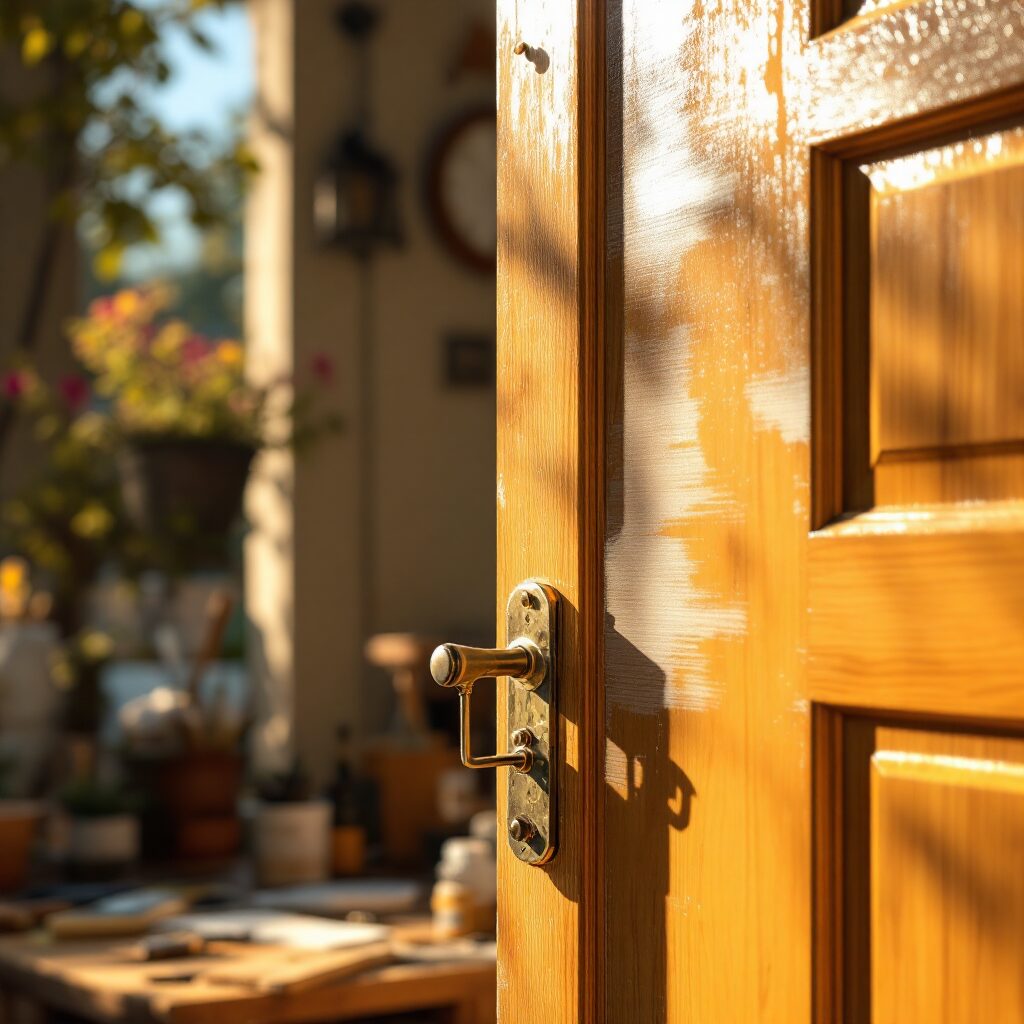
Hardware Updates: Style Meets Security
Door refinishing is the perfect time to upgrade hardware:
-
Baldwin & Schlage locks — high quality and stylish.
-
Oil-rubbed bronze handles — timeless look.
-
Smart locks (Yale, August) — modern convenience and security.
Small hardware upgrades can elevate curb appeal and strengthen security.
Environmental & Economic Benefits
Choosing to refinish instead of replace doesn’t just protect your doors—it benefits both your wallet and the environment.”
- Improves energy efficiency by sealing gaps.
- Reduces waste by preserving doors.
- Saves money: refinishing $300–$600 vs replacement $2000–$4000+.
The U.S. Department of Energy – Weatherization Program shows that sealing and refinishing entry doors prevents air leakage, improving comfort and lowering utility costs in humid regions like Georgia.
Refinishing is eco-friendly and delivers significant financial savings over time.
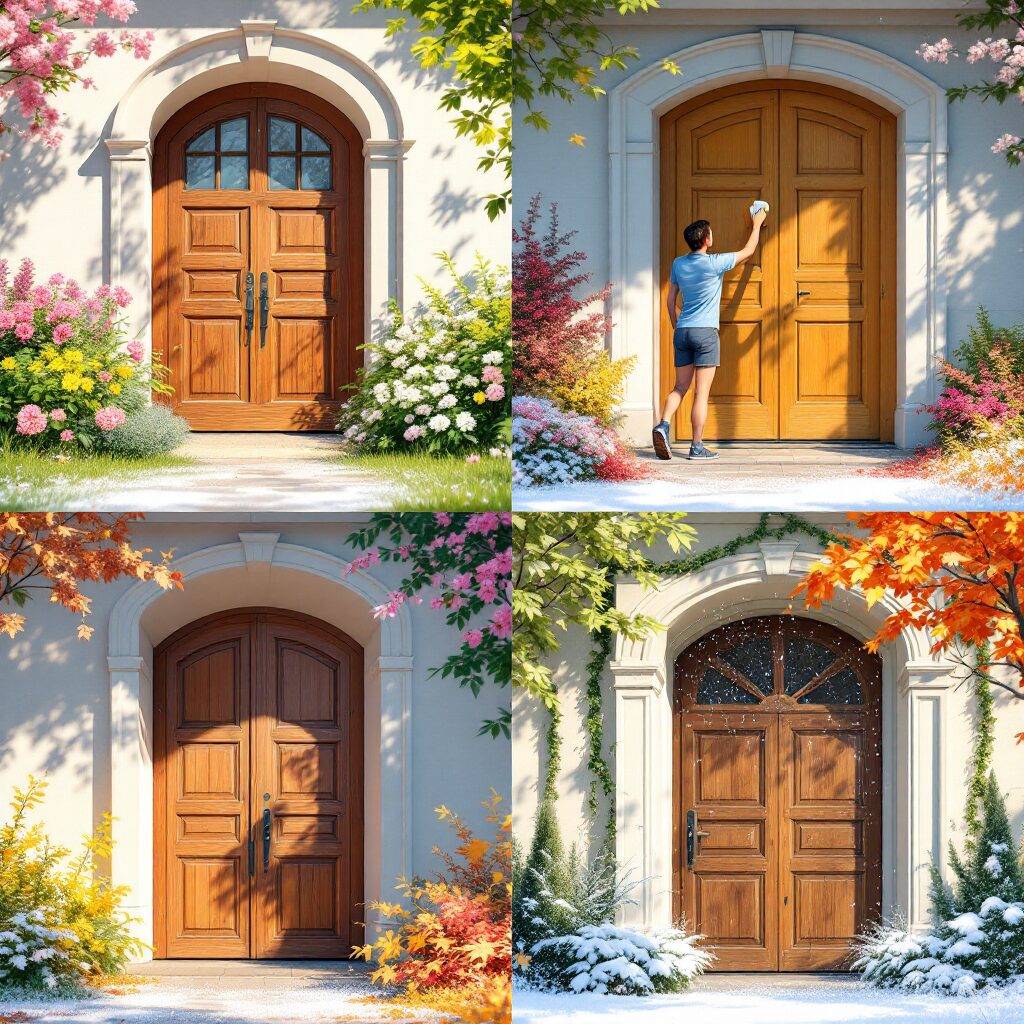
Seasonal Maintenance Checklist
Each season brings unique challenges for your doors, making regular upkeep essential.
- Spring: Inspect for mildew or damage.
- Summer: Apply UV protectant.
- Fall: Reseal before storm season.
- Winter: Clean hardware, check for drafts.
Following seasonal care extends your door’s lifespan and maintains strong curb appeal.
DIY vs Professional Refinishing
When it comes to refinishing, the choice between a DIY project and hiring a professional can make all the difference in results and durability.
DIY
Taking the do-it-yourself route appeals to budget-minded homeowners, but it comes with trade-offs in quality and longevity
- Lower upfront cost.
- Risk of streaks and uneven finish.
- Shorter lifespan.
DIY may save money initially but often results in a shorter-lasting finish.
Professional
Turning to skilled pros means paying more upfront, yet the payoff is a flawless finish that stands the test of time.
- Expert prep and sanding.
- Commercial-grade products.
- Experienced local pros.
Professional refinishing ensures a durable, polished result worth the investment.
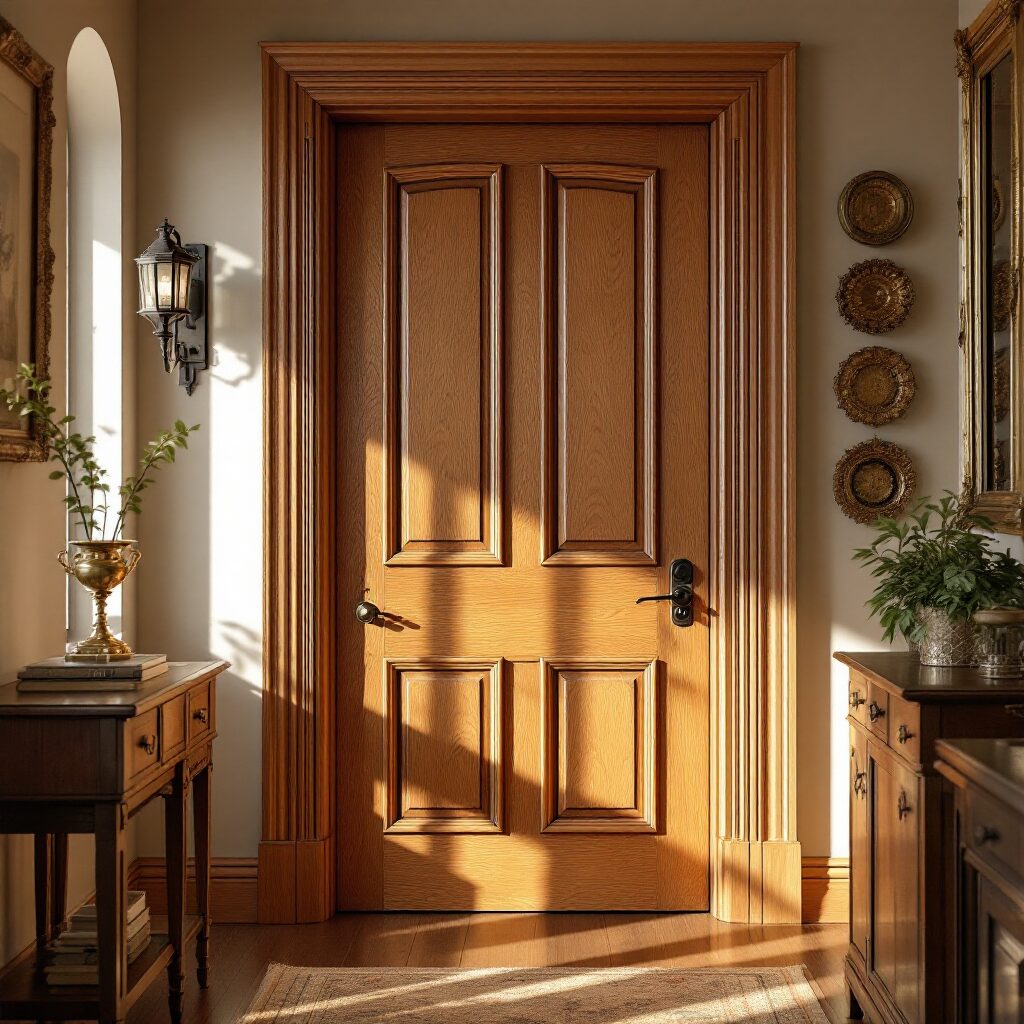
Historic Homes: Preserving Atlanta’s Legacy
Case Study: A 1920s oak door in Buckhead was refinished with oil-based stain and UV varnish and retained its beauty for over 4 years. Refinishing preserves architectural integrity and maintains the historic charm of Atlanta homes.
Cost Comparison: Refinishing vs Replacement
Understanding the true cost difference between refinishing and full replacement helps homeowners make a smarter long-term decision:
| Option | Cost Range | Lifespan | Maintenance | Value |
|---|---|---|---|---|
| Refinishing | $300–$600 | 3–5 yrs | Easy recoat | Preserves wood, cost-effective |
| Replacement | $2000–$4000+ | 10–15 yrs | Low | Expensive, may lose character |
Refinishing provides authentic charm at a fraction of the cost of replacement.
FAQ
-
Which lasts longer in Georgia? Paint may last longer in dry climates, but stain adapts better to humidity.
-
How often should I recoat a stained door in Atlanta? Every 2–4 years depending on exposure.
-
Is refinishing cheaper than replacing? Yes—refinishing costs $300–$600 while replacement starts at $2000+.
FAQs highlight why refinishing with stain is the most balanced choice for Atlanta homeowners.
Final Verdict
Georgia’s climate demands more from your doors. Choose paint if bold colors or HOA compliance matter most. Choose stain for natural beauty, resilience, and easy upkeep. For most Atlanta homes, stain delivers the best long-term value in durability and curb appeal.
DoorStain.com – Georgia’s trusted specialists in wood restoration services, with over 15 years of experience and hundreds of successful projects in Buckhead, Midtown, Decatur, and Sandy Springs.

